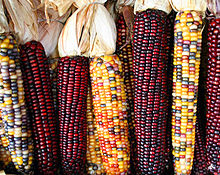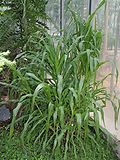Zea(plant)
| Zea | |
|---|---|

| |
| Zea mays | |
| Scientific classification | |
| Kingdom: | Plantae |
| Clade: | Tracheophytes |
| Clade: | Angiosperms |
| Clade: | Monocots |
| Clade: | Commelinids |
| Order: | Poales |
| Family: | Poaceae |
| Subfamily: | Panicoideae |
| Supertribe: | Andropogonodae |
| Tribe: | Andropogoneae |
| Subtribe: | Tripsacinae |
| Genus: | Zea L. |
| Type species | |
| Zea mays | |
| Synonyms[1] | |
| |
Zeais agenusofflowering plantsin thegrass family.The best-known species isZ. mays(variously calledmaize,corn, or Indian corn), one of the most important crops for human societies throughout much of the world. The four wild species are commonly known asteosintesand are native toMesoamerica.
Etymology[edit]
Zeais derived from theGreekname (ζειά) for another cereal grain (possiblyspelt).[2]
Recognized species[edit]

The five acceptedspeciesnames in thegenusare:[3][4]
| Ear | Plant | Scientific name | Common Name | Distribution |
|---|---|---|---|---|
 |
 |
Zea diploperennisH.H.Iltis et al. | diploperennial teosinte | Jalisco |
 |
Zea luxurians(Durieu & Asch.) R.M.Bird | Maíz de Monte, Florida teosinte and Guatemalan teosinte | Chiapas,Guatemala,Honduras | |
 |
 |
Zea maysL. | Corn, Maize | southernMexico,Guatemala; cultivated in many places |
| Zea nicaraguensisH.H.Iltis & B.F.Benz | Nicaraguan teosinte | Nicaragua | ||
 |
Zea perennis(Hitchc.) Reeves &Mangelsd. | perennial teosinte | Jalisco |
Maize(Zea mays) is further divided into four subspecies:Z. m. huehuetenangensis,Z. m. mexicana,Z. m. parviglumis(Balsas teosinte, the ancestor of maize), andZ. m. mays.[4]The first three subspecies are teosintes; the last ismaize,or corn,[4]the only domesticatedtaxonin the genusZea.[citation needed]
The genus is divided into twosections:Luxuriantes,withZ. diploperennis,Z. luxurians,Z. nicaraguensis,Z. perennis;andZeawithZ. mays.The former section is typified by dark-staining knobs made up ofheterochromatinthat are terminal on mostchromosomearms, while most subspecies of sectionZeamay have none to three knobs between each chromosome end and thecentromereand very few terminal knobs (exceptZ. m. huehuetenangensis,which has many large terminal knobs).[citation needed]
Description[edit]

Bothannualandperennialteosinte species occur.Z. diploperennisandZ. perennisare perennial, while all other species are annual. All species arediploid(n=10) with the exception ofZ. perennis,which istetraploid(n=20). The different species and subspecies of teosinte can be readily distinguished based on morphological, cytogenetic, protein, and DNA differences and on geographic origin. The two perennials aresympatricand very similar and some consider them to be one species. What many consider to be the most puzzling teosinte isZ. m. huehuetenangensis,which combines a morphology rather likeZ. m. parviglumiswith many terminal chromosome knobs and an isozyme position between the two sections. Considered to be phenotypically the most distinctive, as well as the most threatened, teosinte isZea nicaraguensis.This teosinte thrives in flooded conditions along 200 m of a coastal estuarine river in northwest Nicaragua.
Teosintes strongly resemble maize in many ways, notably their tassel (male inflorescence) morphology. Teosintes are distinguished from maize most obviously by their numerous branches each bearing bunches of distinctive, small femaleinflorescences.These spikes mature to form a two-ranked 'ear' of five to 10 triangular or trapezoidal, black or brown disarticulating segments, each with one seed. Each seed is enclosed by a very hard fruitcase, consisting of a cupule or depression in the rachis and a tough lower glume. This protects them from the digestive processes ofruminantsthat forage on teosinte and aid in seed distribution through their droppings. Teosinte seed exhibits some resistance to germination, but will quicklygerminateif treated with a dilute solution of hydrogen peroxide.
Origin of maize and interaction with teosintes[edit]
Maize is a grass, related tosorghumand more distantly toriceandwheat.The genusZeais closely related toTripsacum,gamagrass.[5]
| (Part ofPoaceae) | |
Teosintes are critical components ofmaize domestication,but opinions vary about whichtaxawere involved. According to the most widely held evolutionary model, the crop was derived directly fromZ. m. parviglumisby selection of key mutations;[6]but in some varieties up to 20% of itsgenetic materialcame fromZ. m. mexicanathroughintrogression.[7]
All but theNicaraguanspecies of teosinte may grow in or very near corn fields, providing opportunities forintrogressionbetween teosinte and maize. First, and later-generation hybrids are often found in the fields, but the rate of gene exchange is quite low. Some populations ofZ. m. mexicanadisplayVavilovian mimicrywithin cultivated maize fields, having evolved a maize-like form as a result of the farmers' selective weeding pressure. In some areas ofMexico,teosintes are regarded by maize farmers as a noxiousweed,while in a few areas, farmers regard it as a beneficialcompanion plant,and encourage itsintrogressioninto their maize.
Early dispersal of maize in the Americas[edit]
According to Matsuoka et al., the available early maize gene pool can be divided into three clusters:
- An Andean group, that includes the hand-grenade-shaped ear types and some other Andean maize (35 plants);
- All other South American and Mexican maize (80 plants);
- U.S. maize (40 plants)
Also, some other intermediate genomes, or admixtures of these clusters occur.
According to these authors, "The maize of the Andes Mountains with its distinctive hand grenade-shaped ears was derived from the maize of lowland South America, which in turn came from maize of the lowlands of Guatemala and southern Mexico."[6]
Ecology[edit]
Zeaspecies are used as food plants by thelarvae(caterpillars) of someLepidopteranspecies including (in the Americas) thefall armyworm(Spodoptera frugiperda), the corn earworm (Helicoverpa zea), and the stem borersDiatraeaandChilo;in the Old World, it is attacked by thedouble-striped pug,the cutwormsheart and clubandheart and dart,Hypercompe indecisa,therustic shoulder-knot,thesetaceous Hebrew characterandturnip moths,and theEuropean corn borer(Ostrinia nubilalis), among many others.
Virtually all populations of teosintes are either threatened or endangered:Z. diploperennisexists in an area of only a few square miles;Z. nicaraguensissurvives as about 6000 plants in an area of 200 × 150 m. The Mexican and Nicaraguan governments have taken action in recent years to protect wild teosinte populations, using bothin situandex situconservation methods. Currently, a large amount of scientific interest exists in conferring beneficial teosinte traits, such as nitrogen fixation,[8]insect resistance, perennialism, and flood tolerance, to cultivated maize lines, although this is very difficult due to linked deleterious teosinte traits.
Genomics[edit]
Gene flowfromgenetically modified maizeto teosinte weeds has only been observed to produce a GM teosinte with the same trait but this may not always be the outcome.[9]Teosinte with a different insertion of thetransgenemay result and functionally different outcomes may be produced.[9]
References[edit]
- ^Kew World Checklist of Selected Plant Families
- ^Gledhill, David (2008). "The Names of Plants".Cambridge University Press(CUP).ISBN9780521866453(hardback),ISBN9780521685535(paperback). pp 411
- ^"ITIS - Report: Zea".
- ^abcWu, Chi-Chih; Diggle, Pamela K.; Friedman, William E. (September 2011). "Female gametophyte development and double fertilization in Balsas teosinte,Zea mayssubsp.parviglumis(Poaceae) ".Sexual Plant Reproduction.24(3): 219–229.doi:10.1007/s00497-011-0164-1.PMID21380710.S2CID8045294.
- ^Gaut, Brandon S.; Le Thierry d'Ennequin, Maud; Peek, Andrew S.; Sawkins, Mark C. (2000-06-20)."Maize as a model for the evolution of plant nuclear genomes".Proceedings of the National Academy of Sciences.97(13): 7008–7015.Bibcode:2000PNAS...97.7008G.doi:10.1073/pnas.97.13.7008.ISSN0027-8424.PMC34377.PMID10860964.
- ^abMatsuoka, Y.; Vigouroux, Y.; Goodman, M. M.; Sanchez G., J.; Buckler, E.; Doebley, J. (30 April 2002)."A single domestication for maize shown by multilocus microsatellite genotyping".Proceedings of the National Academy of Sciences.99(9): 6080–6084.Bibcode:2002PNAS...99.6080M.doi:10.1073/pnas.052125199.PMC122905.PMID11983901.
- ^Hufford, Matthew B.; Lubinksy, Pesach; Pyhäjärvi, Tanja; Devengenzo, Michael T.; Ellstrand, Norman C.; Ross-Ibarra, Jeffrey (9 May 2013)."The Genomic Signature of Crop-Wild Introgression in Maize".PLOS Genetics.9(5): e1003477.doi:10.1371/journal.pgen.1003477.PMC3649989.PMID23671421.
- ^Van Deynze, Allen; Zamora, Pablo; Delaux, Pierre-Marc; Heitmann, Cristobal; Jayaraman, Dhileepkumar; Rajasekar, Shanmugam; Graham, Danielle; Maeda, Junko; Gibson, Donald; Schwartz, Kevin D.; Berry, Alison M.; Bhatnagar, Srijak; Jospin, Guillaume; Darling, Aaron; Jeannotte, Richard; Lopez, Javier; Weimer, Bart C.; Eisen, Jonathan A.; Shapiro, Howard-Yana; Ané, Jean-Michel; Bennett, Alan B. (7 August 2018)."Nitrogen fixation in a landrace of maize is supported by a mucilage-associated diazotrophic microbiota".PLOS Biology.16(8): e2006352.doi:10.1371/journal.pbio.2006352.PMC6080747.PMID30086128.
- ^ab
- Bauer-Panskus, Andreas; Miyazaki, Juliana; Kawall, Katharina; Then, Christoph (2020)."Risk assessment of genetically engineered plants that can persist and propagate in the environment".Environmental Sciences Europe.32(1).Springer Science and Business Media LLC.doi:10.1186/s12302-020-00301-0.ISSN2190-4707.S2CID211540730.
- This review cites this research.
External links[edit]
Zea (genus).
- Carroll, Sean B. (24 May 2010)."Tracking the Ancestry of Corn Back 9,000 Years".The New York Times.
